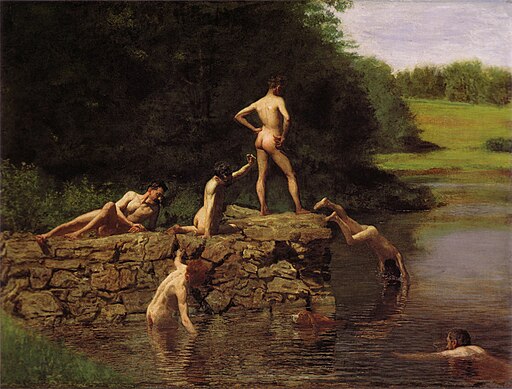“I never knew but one artist,” wrote the poet Walt Whitman. “and that’s Tom Eakins, who could resist the temptation to see what they think ought to be, rather than what is.”
I am confronted with one of Eakins most notable paintings, Swimming, in the Amon Carter Museum. I’ve heard it said more than once that it’s one of the most important paintings in the collection and more visitors make the Amon Carter their destination because of it than any other single work.
Whitman was likely referring to portraits by the Philadelphia artist, namely his own which he was quite satisfied with. While most of Eakins works are rather straight forward, Swimming may be a notable exception. I think perhaps this is because it comes closer to Eakins the man than any other, and to say he was complicated can be considered an understatement.
William McFeely’s book Portrait; The Life of Thomas Eakins devotes a chapter to the painting. “Recently Swimming has been understood almost exclusively as auto-biographical, evidence of Eakins’ homosexuality.” It’s a good time to note here that Eakins was married, but as the book suggests his wife Susan may have been in a similar situation.
Most people who know a little about Eakins seem to know he was fired from his teaching position at the Pennsylvania Academy of Fine Arts (PAFA) and that it has something to do with removing the loin cloth from a model. Eakins felt strongly about learning from a nude and even dissected figure. He wasn’t the first, and the debate there would continue, particularly with the use of nude models in mixed classes. The book contends that Eakins wasn’t dismissed after the event, however and only after a group of students, including Eakins’ successor Thomas Anshutz, outed their teacher for being a homosexual. Something said is often much different than something thought.
I’ve heard it said that Eakins was dismissed for painting Swimming, because in part it contained nude images of identifiable students. This could not be the case. When it was first exhibited at PAFA in 1885 it was identified as being owned by Edward Coates, director of the academy. The picture was not received well and not seen in public again until a postmortem show at the Metropolitan Museum of Art.
Swimming was later connected to Whitman’s line “Twenty-eight bathers bathe by the shore” in Song of Myself.
Twenty-eight young men bathe by the shore,
Twenty-eight young men and all so friendly;
Twenty-eight years of womanly life and all so lonesome.
She owns the fine house by the rise of the bank,
She hides handsome and richly drest aft the blinds of the window.
Which of the young men does she like the best?
Ah the homeliest of them is beautiful to her.
Where are you off to, lady? for I see you,
You splash in the water there, yet stay stock still in your room.
Dancing and laughing along the beach came the twenty-ninth bather,
The rest did not see her, but she saw them and loved them.
The beards of the young men glisten’d with wet, it ran from their long hair,
Little streams pass’d all over their bodies.
An unseen hand also pass’d over their bodies,
It descended tremblingly from their temples and ribs.
The young men float on their backs, their white bellies bulge to the sun,
they do not ask who seizes fast to them,
They do not know who puffs and declines with pendant and bending arch,
They do not think whom they souse with spray.
Not unlike the woman watching from the window in Whitman’s verse, Eakins has entered the water first and remains hidden below its waves. The painting is not known to have been viewed by Whitman.
McFeeley notes that while the spirit of the work may be male to male, it’s purpose may be less sexual and more of a general humane expression. “In his own time, he was not heard, but his message was one of particularly American freedom,” McFeeley wrote. “One that included the sexual.” For poets like Whitman, along with Thoreau and Emerson, nature was often used as a metaphor for this freedom.
“I would simply argue that Eakins, like these writers, dreamed of a world where the pursuit of happiness could be sought on his own terms,” McFeeley wrote. “He would have the naive view that such happiness would inevitably be his; it was not to be.”
McFeeley provides some lines from an Emily Dickinson poem that seem as though they may describe the Eakins early experience at using his paintbrush as a slingshot against the world.
I took my Power in my Hand–
And went against the World–
‘Twas not so much as David—had–
But I—was twice as bold–
I aimed my Pebble—but Myself
Was all the one that fell–
Was it Goliath—was too large–
Or was myself—too small?
Discover more from Urban Art & Antiques
Subscribe to get the latest posts sent to your email.


